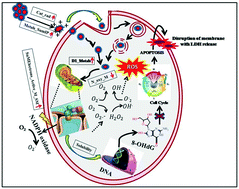Assessment of toxicity of metal oxide and hydroxide nanoparticles using the QSAR modeling approach†
Abstract
Nowadays, nanotechnology is a promising area of research. Therefore, a detailed understanding of comprehensive risk assessment of nanomaterials and their behavior to the biological system is required before working with any metallic oxide (hydroxide) nanoparticles (MeOx NPs). Empirical testing of all toxicity endpoints of MeOx NPs is impossible with limited resources; therefore, an efficient alternative method complementary to experimentation is very essential. Quantitative structure–activity relationship (QSAR) models are widely adopted to predict the toxicity of untested nanomaterials. In the present study, QSAR models were developed to computationally evaluate the cytotoxicity of MeOx NPs towards RAW 264.7 cells. Both MLR and PLS models were developed with 25 NPs (nanoparticles) from 6 metal (hydro) oxide families (SiO2, TiO2, CeO2, AlOOH, ZnO, and Ni(OH)2) using the release of lactate dehydrogenase (ldhR) from the cell as the endpoint. Multiple linear regression (MLR) models were developed using the best subset selection method followed by enhancement of model derived predictions by the application of the intelligent consensus predictor (ICP) tool. On the other hand, a partial least squares (PLS) model was developed using the Small Dataset Modeler software which can handle a limited number of data points. Periodic table descriptors and some physicochemical descriptors have been used to characterize the nanostructure of MeOx NPs. All models were validated meticulously by employing internal and external validation metrics followed by the randomization test and applicability domain (AD) study. The statistical metric values suggested the robustness of the models. The insights from both models suggested that electronegativity, solubility, formation of a metal cation increase the cytotoxicity whereas non-metal NPs and an increase of the oxidation degree contribute to low toxicity towards RAW 264.7 cells. A short proposed mechanism has also been explained to determine the cause of cellular toxicity by the MeOx NPs.

- This article is part of the themed collections: RSC Environmental Science journals: Highlights from India and Best Papers 2021 - Environmental Science: Nano


 Please wait while we load your content...
Please wait while we load your content...